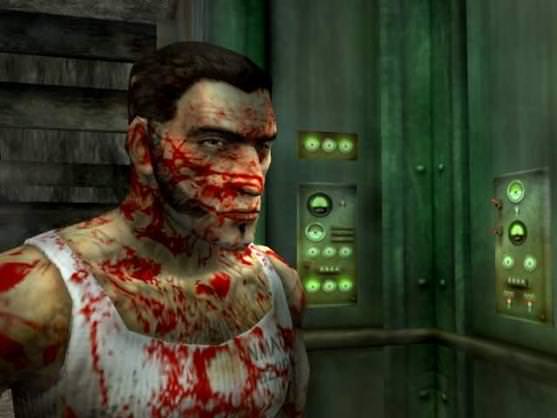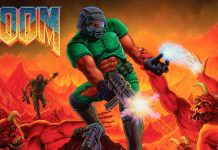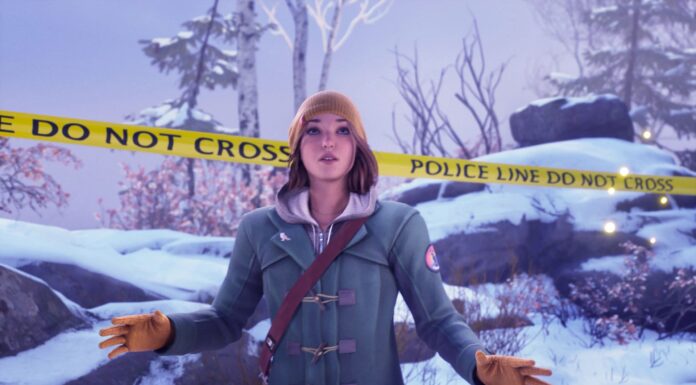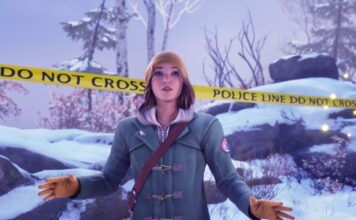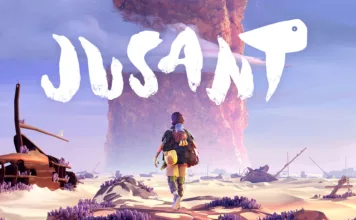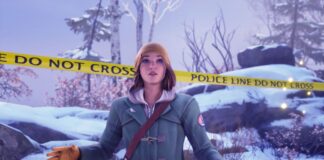Continuing the trend of gory horror for Halloween, now with less goth and more grit, I sat down and played through The Suffering and The Suffering: Ties That Bind. Two games that I’ve been meaning to play since the first came out over 10 years ago, they were more than met the eye.
The Suffering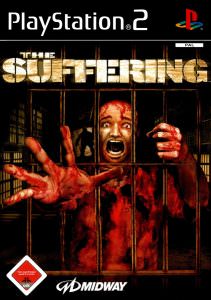
In many ways, if you’re looking for a more recent comparison, The Suffering feels like Dead Space. It’s an assault on the senses populated by blood and filth-spattered nasties who never let up for long. It’s also the type of survival horror that’s so fast paced that it skirts the line at being simply a gory action game.
These days it’s a pretty bog standard third-person shooter, embodying design trends that are still around 11 years later. It’s dated, but functional. This, combined with the fact there’s little variety inside the game makes completing it fairly humdrum, far outstaying it’s welcome. With only 7 enemies to take on in a 9~ hour game (one of which barely constitutes as an enemy), things got far too routine to really put the fear in me.
Levels are too long and all too repetitive to look at, with one or two being outright labyrinthine. I spent a good hour doing laps of the fucking mental asylum, trying to remember which copy-pasted hallway had which copy-pasted door I needed to go in next. It all smacks of a game with a small budget, made a generation before it’s time.
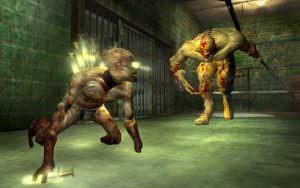 If it weren’t for the dated graphics though the Clive Barker-esque monster designs would be much more disturbing. All of which are based off various forms of execution carried out on Carnate Island; an east-coast version of Alcatraz were our main character, Torque, finds himself on death-row for the apparent murder of his ex-wife and two sons. And this is where the game really gets interesting.
If it weren’t for the dated graphics though the Clive Barker-esque monster designs would be much more disturbing. All of which are based off various forms of execution carried out on Carnate Island; an east-coast version of Alcatraz were our main character, Torque, finds himself on death-row for the apparent murder of his ex-wife and two sons. And this is where the game really gets interesting.
Despite being an otherwise grindhousey splatterfest, the subjects The Suffering brings up are surprisingly deep and inspired. From the present prison industrial complex, to America’s dark blood-laden past, mental illness, wartime paranoia, torture and racism make up both the plot and the lore. It informs enemy and location design, and creates a setting were every single character is morally grey.
Accurately, most prisoners are African American, and those that aren’t are either skinheads of the most heinous of monsters. That and the blurring of lines of the “good” corrections officers and “bad” prisons once demons infest the island makes it an interesting setting to have a moral choice system.
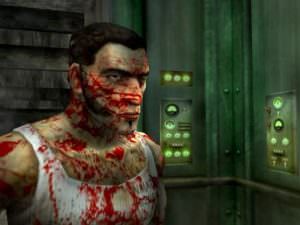 It’s a bit obvious in practice; if you see anyone asking for your help, help them and you get good karma and unlock the good ending, or shoot them in the face and get bad karma….though there’s no benefit in doing so. It leads to situations were, for example, a prisoner asked me to help him get his raft off the island so he could sail to freedom, but I have no idea what he was in there for. For all I knew, I could have been sending a child-rapist off to continue his spree, but because it’s an immediately nice thing to do, good karma for me.
It’s a bit obvious in practice; if you see anyone asking for your help, help them and you get good karma and unlock the good ending, or shoot them in the face and get bad karma….though there’s no benefit in doing so. It leads to situations were, for example, a prisoner asked me to help him get his raft off the island so he could sail to freedom, but I have no idea what he was in there for. For all I knew, I could have been sending a child-rapist off to continue his spree, but because it’s an immediately nice thing to do, good karma for me.
It’s an example of a moral choice system done wrong. Splitting morality into “good” and “bad” generally leads to base level decision-making were you’re reminded you’re playing a game. Likewise, early on you’ll just pick your path and stick to it throughout, meaning decision-making goes out the window anyway.
If only the game didn’t chock those decisions down to “good” or “bad”, you’d have a real moral dilemma on your mind and some very hard choices to make. Even now I’m still debating with myself over what was the “right” thing to do in those situations. Which is a testament to how shockingly deep the game’s themes are; does anyone have the right to condemn a “bad” person to death? How many innocent people are locked away every day? How many bad people are policing them?
 Those good choices and bad choices decide, among other smaller details, the end reveal were we find out whether Torque did or didn’t murder his family. As a silent protagonist, it’s left to our imagination throughout. Apparently, as a guard tells us, he claims he blacked out during the murder and remembers nothing, only to be found at the scene of the crime and arrested. Not only is his guilt or innocence in our hands, how he feels about the crime and how he felt about his family prior to their death is something informed by how we read and react to his world.
Those good choices and bad choices decide, among other smaller details, the end reveal were we find out whether Torque did or didn’t murder his family. As a silent protagonist, it’s left to our imagination throughout. Apparently, as a guard tells us, he claims he blacked out during the murder and remembers nothing, only to be found at the scene of the crime and arrested. Not only is his guilt or innocence in our hands, how he feels about the crime and how he felt about his family prior to their death is something informed by how we read and react to his world.
Torque is a scumbag, but how much of a scumbag he is and why he’s a scumbag is kept ambiguous. Which I loved. To bring it back to Dead Space; there you have another silent protagonist who’s looking for his missing girlfriend, going to life-threatening lengths just to find her. With no guarantee that she’s even alive, we can only assume that they must have an amazing relationship. But we’re never given any sense of it and never once asked to ponder on it.
The Suffering managed to make it make it so much more interesting. Torque could be innocent of the murder and just a victim of racial profiling or a set-up, but he did have a past of crime and could have attracted the wrong sort of attention. Where you draw the line on his responsibility is something that plays on your mind even after you finish the game and get the good, bad or neutral ending.
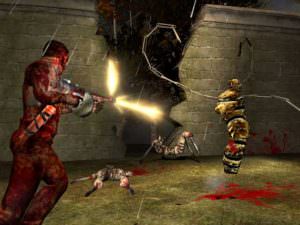 In many ways, I was surprised by how fascinating the story was, because the gameplay and the cartoony, primitive graphics ran contrary to the drama. The simplistic game design, good story or no, dragged on far too long and as I watched Torque escape Carnate island, I was relieved it was over.
In many ways, I was surprised by how fascinating the story was, because the gameplay and the cartoony, primitive graphics ran contrary to the drama. The simplistic game design, good story or no, dragged on far too long and as I watched Torque escape Carnate island, I was relieved it was over.
But I still wanted more. It leaves so many questions unanswered, not just about Torque’s relationship to his family or what happens to some supporting characters, but the very nature of the demon infestation and why Torque can turn into a demon himself.
And, on a more horrifying note, how much unnecessary suffering there is in the world. After getting a glimpse at the dark side of America and how it treats minorities, I could help but linger on the topics in brings up. Despite it being an edgy shooter, it leaves you with a sense of dread and a considerately dark outlook on society.
The Suffering: Ties That Bind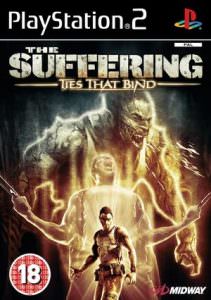
Landing on new shores, Torque finds himself in Baltimore and immediately the quality takes a jump forward. Graphics are better, there are more than double the variety of enemies to fight, level design is more compact, there’s no repeating areas, and everything feels tighter and more polished than before. Just about everything that bothered me about the first game is fixed (bar the moral choice system, but that’s more of a matter of taste).
In hindsight, it makes the first game feel like a beta; only laying down the fundamentals of the game but not fully realising it’s potential. Ties That Bind takes what was there and in the space of only a year, had the team whip it into shape. While still flawed, it’s a shining example of a sequel done right.
There are significant changes to gameplay too numerous to mention, but the two weapon limit and changes to the health system (now healing you the second you pick up pills, rather than storing them for later) make things much more frantic and difficult. The first game was a on the easy side, and while this one is a nice mid-ground for the most part, it gets fucking hellish towards the end, to the point that I resorted to cheats just to finish it.
 The variety in enemies, now with a total of 12 Hellraiser nasties and human mercenaries, all of which come in at least one different form, make sure things stay fresh until the end. Tactics for dealing with them change organically as they switch from melee swarms you’ll need to herd and back away from, and tense shootouts were you need to act fast and avoid getting in anyone’s line of sight.
The variety in enemies, now with a total of 12 Hellraiser nasties and human mercenaries, all of which come in at least one different form, make sure things stay fresh until the end. Tactics for dealing with them change organically as they switch from melee swarms you’ll need to herd and back away from, and tense shootouts were you need to act fast and avoid getting in anyone’s line of sight.
Again, it’s hard to point out anything too remarkable or groundbreaking in how it plays, but it’s a solid shooter that anyone even vaguely familiar with games could pick up and play.
But that’s not what I care about with The Suffering. I want to know about the story.
After escaping Carnate island, Torque winds up in his hometown of Baltimore; a place were the zombie apocalypse would go unnoticed and where it would take whatever satanstorm that razed Carnate to fuck the place up further. Captured by a militia called “The Foundation”, we’re only ever given a vague sense that there’s something special about Torque and that their contractor, Jordan, wants him for some sort of experiment. That plotline takes a backseat to an introspective journey Torque must take to find out why his past continues to haunt him.
 Again, Torque’s relationship with his ex-wife and kids is ambiguous enough to let you decide how he felt about them, but now Torque’s own past and his relationship with crime kingpin Blackmoore has the spotlight. And again, even heavier now, the game brings up some very deep, socially conscious topics that will have you thinking twice on whether you should condemn criminals or not.
Again, Torque’s relationship with his ex-wife and kids is ambiguous enough to let you decide how he felt about them, but now Torque’s own past and his relationship with crime kingpin Blackmoore has the spotlight. And again, even heavier now, the game brings up some very deep, socially conscious topics that will have you thinking twice on whether you should condemn criminals or not.
There is a moment early on were the ghost of Torque’s wife guides you to their home so you can figure out what to do next. You’re led into “the projects”; the slums that make up most of to locations of The Wire. You climb through an old, broken window (the only one not boarded up) and you get to see Torque’s tiny, run down home. As you walk through, a train passes right by the windows on the back wall and the whole house shakes violently.
You’re left to think about how bad of a hand Torque was dealt in life by simply being born brown in the wrong side of town. You can imagine, with a wife and two kids, why he would turn to a life of crime. You can imagine why anyone in his situation would turn to a life of crime.
The monsters are now primarily based on street crime rather than execution. Monsters that once represented lethal injections now represent heroin addiction, and new creatures embody drive-by shootings, a history of cheap labour and cannibalism in Maryland’s past. You’re taken on a historical tour that again brings up institutionalised racism and all the poverty and crime it brings.
 One particular nasty called The Creeper, possibly one of the most disturbing enemies in any game ever, is a demonic version of a pimp-turned-serial killer who was never caught while he was still alive. Just as you think the game is going to be flat out exploitative about it, his profile makes the case that if missing and dead prostitutes weren’t seen as “the less-dead” by the authorities, The Creeper would have been caught, and 50+ women wouldn’t have died horrible deaths.
One particular nasty called The Creeper, possibly one of the most disturbing enemies in any game ever, is a demonic version of a pimp-turned-serial killer who was never caught while he was still alive. Just as you think the game is going to be flat out exploitative about it, his profile makes the case that if missing and dead prostitutes weren’t seen as “the less-dead” by the authorities, The Creeper would have been caught, and 50+ women wouldn’t have died horrible deaths.
This blend of social-consciousness and gory, 90s comic horror is strange to behold. I can’t tell if one is holding back the other or if it was part of the plan. It could be genuine and the team simply didn’t know how to handle it any way other than making a gory shooter that’s a bit too fun. Or it could be tasteless and exploitative, with little reverence for the subject matter at hand. I won’t claim offence at either, because what right do I have, but it’s certainly interesting and I can’t think of another game that bases it’s designs around institutional racism or a history of distinctly American poverty. It very sympathetic to people who are commonly depicted as “bad guys” in the media.
 Not to spoil the twist and turns of the story, but few of the plot treads get a resolution at the end. The first game keeps you in the dark about why monsters suddenly appear and never makes bones about it, but the second game seems like it’s going to address it straight away…..but then it just doesn’t. Jordan knows why but dies before she has a chance to explain it, only hinting at the cause. Likewise, it doesn’t have much of a commentary about the social themes it brings up. It simply says “hey, maybe you should think twice when you see someone shooting up heroin, they’ve probably been born into it” and lets you make up your own mind.
Not to spoil the twist and turns of the story, but few of the plot treads get a resolution at the end. The first game keeps you in the dark about why monsters suddenly appear and never makes bones about it, but the second game seems like it’s going to address it straight away…..but then it just doesn’t. Jordan knows why but dies before she has a chance to explain it, only hinting at the cause. Likewise, it doesn’t have much of a commentary about the social themes it brings up. It simply says “hey, maybe you should think twice when you see someone shooting up heroin, they’ve probably been born into it” and lets you make up your own mind.
…until the moral choice system comes into play. At one point, while the apocalypse seems to be happening outside, I found myself in a crack house. One of the guys, strung out and dying for his next fix, ran up to me thinking I was his father. Apparently I was supposed to help him get his next dose of heroin (not that the game told me this as it was happening), but a monster killed him before I knew it.Turns out that was a “bad” moral choice, and the game berated me for it later.
…right, whatever you say. Now I’m going to go ahead and not get decapitated by the knife-wielding Pinheads outside, thank you very much.
Both Sufferings are in a nutshell; games that look like dumb gore from their covers, but that actually managed to base themselves around some heavy socially conscious topics. The horror it brings is feverish and panic-inducing while you play, but lingers long after it’s over. If you don’t come out of it with at least some thoughts for the wretched and victimised of America, then you don’t understand the suffering that saturates the earth it was built on.
